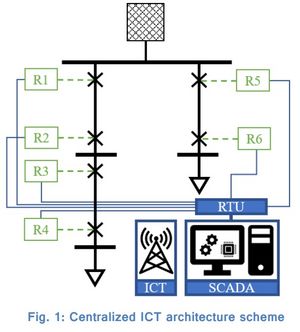Gourab Banerjee is doing his Ph.D. in parallel with the job as a researcher at the University of Kassel. The research focus is in the area of automated and adaptive power system protection considering a high share of inverter-based generations (IBGs) and distributed energy resources (DERs). In his Ph.D. and research investigation, he is considering a future power system model refering to the 3-Ds, i.e., decarbonization, decentralization, and digitalization, and then developing a novel power system protection scheme for high- and medium voltage power grid. In the proposed protection model, the relay devices will adapt their settings themselves in an automated way when the conventional settings are unselective due to change in the short-circuit contribution of DERs, grid topology changes, and changes of grid operating modes.
The overall Ph.D. and research concepts are to develop an automated and smart protection design that will work in a flexible way and adapt its protection threshold during the changes of the abovementioned reasons and will reestablish the sensitivity, selectivity, and reliable operation of the relay devices. Automated protection concepts are one of the solutions that support smart grid operation and the full potential of automation in grid operation, and it is implemented with the help of Information and Communication Technology (ICT). Centralized and decentralized ICT architecture schemes are evaluated based on the grid topology, voltage levels, and requirement of the information exchange between intelligent electronic devices (IEDs). An advantage of an automated adaptation is that no operational personnel needs to be involved in the process, which reduces the manual effort of re-engineering and resetting all the relay thresholds at the control room, and thus reduces operational costs as well as the whole process time.
There is a paper written and already accepted in the IEEE PESS 2021 conference with his master student Pawel Lytaev on “Adaptive and Automated Protection Settings for Over-Current Relays in Radial Grid Configuration”, which will be available in the IEEE Xplore soon. The detailed information of this research can be found as soon it is available. A brief description of this research is mentioned as follows:
Motivation
For smart grid operation, ICT becomes the enabler to automate the state estimation and reconfiguration processes. Distribution system operators usually have a Supervisory Control and Data Acquisition (SCADA) system in their distribution grids, which is capable of performing IEC 60909 three-phase short-circuit calculation. It checks the relay selectivity and sensitivity, especially for relays located far from the source. With the help of the existing SCADA system in the grid, the adaptation information can be sent to the protection device while the grid topology is changed.
It is shown in this research that the automated adaption scheme of the current threshold and time grading improves the sensitivity and selectivity of the nondirectional over-current protection devices. With the help of adaptation and use of ICT, it is possible to set the new ANSI 50/51 relay setting in any radial grid reconfiguration without human interference and manual recalculation. Thus, the operating costs can be reduced. With the help of the existing SCADA system in the grid, the adaptation information can be sent to the protection device while the grid behavior and/or topology is changed.
Research Contribution
In this paper, an adaptive over-current protection scheme with automated dimensioning is introduced. This protection scheme is implemented in a Python-based power system tool pandapower and analyzed in a typical medium voltage (MV) distribution network with several radial grid configurations. Then, this is checked if the protection scheme ensures sensitivity and selectivity to the radial reconfiguration after re-energizing the unsupplied healthy part of the grid. The adaptation is done by re-calculating all current and
time values of each relay after the grid topology changes. The proposed method is implemented considering the topological reconfiguration as a radial grid structure. That means the adaptation of the current threshold and timetripping schedule is applicable for any radial grid topology and its re-configurations. The topological change is determined using a centralized communication architecture, which sends the switching state (open or closed) information of the circuit breakers to a SCADA system during the change of any switching state.The architecture scheme is shown in Fig. 1. This information is transmitted from the relays (R1 to R6) via a remote terminal unit (RTU) to the SCADA system.

Conclusion
- The adaption scheme of the current threshold and time grading improves the sensitivity and selectivity of the nondirectional over-current protection devices.
- With the help of adaptation and use of ICT, it is possible to set the new relay setting in any radial grid reconfiguration without human interference and manual recalculation.
- It is shown that the impact on the used KPI, i.e., the SAIDI (System Average Interruption Duration Index) will decrease, and system reliability improves.
- Furthermore, the proposed method and simulation study is developed based on state-of-theart hardware in the distribution grid. It is not only a technically feasible solution but also does not require substantial economic impact, and it ensures high protection performance, i.e., selectivity, sensitivity and speed.
Contact: Banerjee, Gourab: gourab.banerjee@iee.fraunhofer.de


